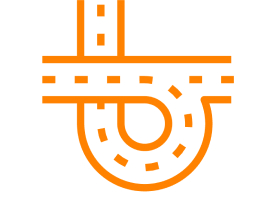Radar and Video Traffic Data Collection
Safe. Non-Intrusive. Efficient.
According to the Bureau of Labor Statistics, the number of fatal work-related injuries at road construction sites averages 123 per year*. For those who spend time collecting traffic data for the betterment of our communities and our commutes, technological advances offer safety and efficiency improvements.
When it comes to traffic data collection, there are many tools available, including radar traffic recorders and video collection devices. Each method and type of equipment has its share of advantages and disadvantages. Radar and video traffic data collection equipment are among the tools B&L has recently acquired for studies requiring volume, speed, and classification data, along with pedestrian, motorized and non-motorized vehicle movements.
Paramount among the advantages of radar traffic recorders is the safety of our staff. Setup and takedown of the recording devices will use less staff and time, making them efficient options that don’t require staff to enter the roadway at any time.
Traffic studies require careful planning regarding the timing of data collection. When traditional tube counters are used, maintenance efforts from a street sweeper can cause damage to the equipment. During the colder months in the Northeast and Mid-Atlantic, snow removal equipment makes the use of traditional intrusive equipment impossible. Winter scenarios can cause a delay of the study until the next optimal time or season. With the use of radar traffic counters, these constraints are removed.
Video collection devices provide B&L with a more efficient means to collect and count motor vehicle, pedestrian, and bicycle direction movements, as well as offer insight into predominant trends, near miss accidents, or other data that may not be realized with traditional methods. Additionally, the video serves as a record for each project that can be used to improve discussions with the public.
Our traffic data acquisition equipment affords us the ability to maximize productivity, efficiency, worker safety and competitiveness. Learn more about these transportation services and how we can put them to work for your community.
*National Institute for Occupational Safety and Health (NIOSH)

This article is from members of the Transportation Practice Area.
Learn More

